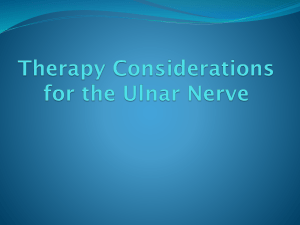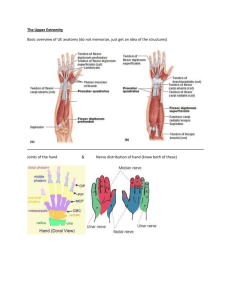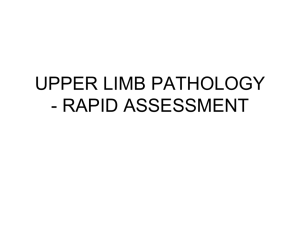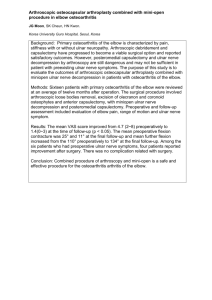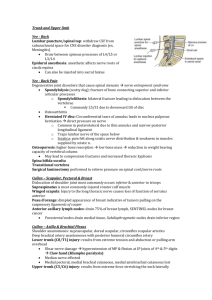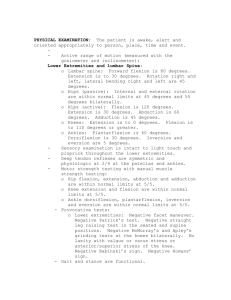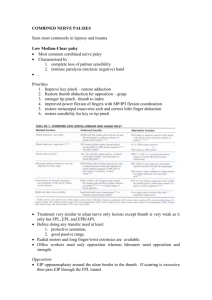Ulnar nerve palsy
advertisement
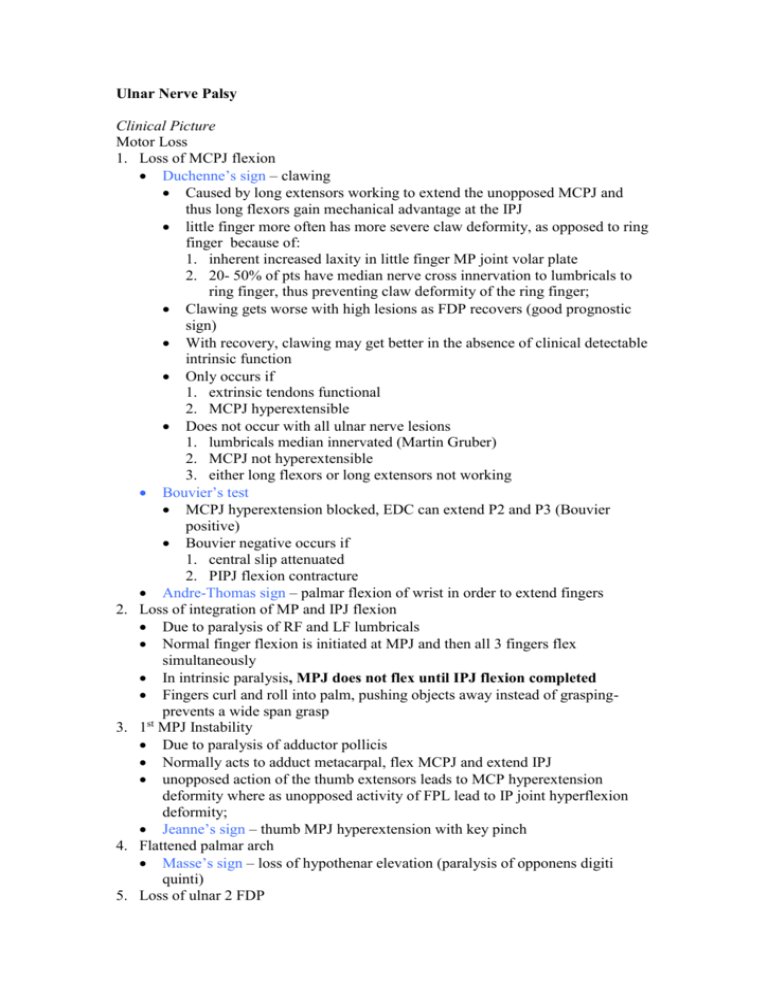
Ulnar Nerve Palsy Clinical Picture Motor Loss 1. Loss of MCPJ flexion Duchenne’s sign – clawing Caused by long extensors working to extend the unopposed MCPJ and thus long flexors gain mechanical advantage at the IPJ little finger more often has more severe claw deformity, as opposed to ring finger because of: 1. inherent increased laxity in little finger MP joint volar plate 2. 20- 50% of pts have median nerve cross innervation to lumbricals to ring finger, thus preventing claw deformity of the ring finger; Clawing gets worse with high lesions as FDP recovers (good prognostic sign) With recovery, clawing may get better in the absence of clinical detectable intrinsic function Only occurs if 1. extrinsic tendons functional 2. MCPJ hyperextensible Does not occur with all ulnar nerve lesions 1. lumbricals median innervated (Martin Gruber) 2. MCPJ not hyperextensible 3. either long flexors or long extensors not working Bouvier’s test MCPJ hyperextension blocked, EDC can extend P2 and P3 (Bouvier positive) Bouvier negative occurs if 1. central slip attenuated 2. PIPJ flexion contracture Andre-Thomas sign – palmar flexion of wrist in order to extend fingers 2. Loss of integration of MP and IPJ flexion Due to paralysis of RF and LF lumbricals Normal finger flexion is initiated at MPJ and then all 3 fingers flex simultaneously In intrinsic paralysis, MPJ does not flex until IPJ flexion completed Fingers curl and roll into palm, pushing objects away instead of graspingprevents a wide span grasp st 3. 1 MPJ Instability Due to paralysis of adductor pollicis Normally acts to adduct metacarpal, flex MCPJ and extend IPJ unopposed action of the thumb extensors leads to MCP hyperextension deformity where as unopposed activity of FPL lead to IP joint hyperflexion deformity; Jeanne’s sign – thumb MPJ hyperextension with key pinch 4. Flattened palmar arch Masse’s sign – loss of hypothenar elevation (paralysis of opponens digiti quinti) 5. Loss of ulnar 2 FDP Pollock’s sign - inability to flex distal phalanges of ring/little finger Kapadji’s sign – loss of ulnar hook. Place examiner’s index finger on patient’s palm and ask patient to hook DIPJ around finger. Patient will have unable to resist force extension of the hook 6. FCU paralysis Slightly weakened wrist flexion 7. Impairment of precision grip Related to loss of intrinsics Inability to cross index/middle fingers on flat surface – tests 1st volar and 2nd dorsal interossei Pitres-Testut sign – inability to abduct middle finger in radial or ulnar direction; also inability to bring all extended fingers into a cone Wartenberg’s sign – EDM unopposed causing LF adduction (main differential – rupture of deep transverse metacarpal ligament) 8. Loss of distal stability and rotation for tip pinch Froments sign - flexion of IPJ with attempted key pinch Bunnell’s O sign Impairment in power grip is greater that the loss of power for precise grip Sensory Loss 9. Loss of ulnar one and a half fingers 10. Loss of ulnar dorsum of hand – high nerve lesion Main complaint of patients with ulnar nerve paralysis is the loss of effective pinch and coordination between the thumb and the index finger. Variations in Ulnar nerve supply 1. predominantly C8 and T1, in 5-10% FCU is innervated by C7 rather than C8/T1 2. Martin-Gruber anastamoses a. High communication from median to ulnar b. Usually motor, sensory has been described c. Incidence 10-30% (most quote 15-17%) d. May arise from i. anastomosis arose from the branch of the median nerve to the superficial forearm flexor muscles (47%); intimately related to the anterior ulnar recurrent artery, and connected with the ulnar nerve about 2 cm below the medial epicondyle (range from 1.6 –2.5 cm) very close to the level at which the ulnar nerve gave off its branch to flexor digitorum profundus ii. anastomosis arose between the origin of the branch to the superficial forearm flexors and the origin of the anterior interosseous nerve in the main trunk (11%) iii. anastomotic branch arose from the anterior interosseous nerve (32%) - passes medially to join the ulnar nerve in either its upper or middle one-third. e. Riche-Cannieu f. Prevalence 1-4% rd 3. 3 lumbrical has dual innervation in 50% of hands 4. 1st dorsal interossei is innervated completely or partially by median nerve in 10%, radial nerve in 1% 5. Dorsal ulnar border of hand may be supplied by radial nerve Timing of tendon transfers Early Indications 1. where recovery is unlikely – segmental proximal nerve injury 2. internal splints o external splints usually awkward and interfere with rehabilitation of sensibility o to maintain dynamic positions for functional coordination and sensibility reeducation o to prevent deformity o decrease cortical exclusion NOTE: FDS LF/RF cannot be used for high ulnar nerve lesions INTERNAL SPLINTING Superficialis Y Technique (Omer) Addresses: 1. intergration of finger flexion 2. key pinch 3. flattened metacarpal arch FDS RF or MF Less suitable for high palsies 3 slips fashioned o Radial slip under FDPs and attached to adductor pollicis o 2 ulnar slips to RF and LF looping under and over A2 If Bouvier negative, then these slips are passed radial and dorsal to attach to insertion of central slip Combine with Thumb arthrodesis if positive Jeanne’s sign following FDS transfer o Improves distal stability for tip pinch o The joint is approached through a dorsal EPL splitting approach and a chevron shaped arthrodesis is performed o A desired flexion of 10-15 degrees is required and k wire fixation for 6 weeks o This combination will improve 4 of 6 lost motor function, does not add strength to power grip and reduces grip strength if FDS RF used CONVENTIONAL TECHNIQUES Proximal Phalanx Flexion Aim to prevent MPJ hyperextension to allow proximal phalanx flexion One of the debates is whether to address just the RF and LF or whether to do all the fingers. Brand states that the I and M will ultimately also develop clawing as the palmar soft tissues stretch and he therefore advocates doing all 4. (may only be apparent during power pinch) The Zancolli operation also deals with all 4. Must be determined if claw is actively correctable (by Bouvier test) Static Block Techniques Only 1 function – correction of deformity. Indicated only when transfers are not available because of extensive paralysis 1. Bone block on dorsum of metacarpal head (Mikail) 2. Arthrodesis of MCPJ – limits flexion of fingers into palm 3. Capsulodesis (Zancolli, 1957 - poor procedure) volar approach to MPJ. Volar plate proximal base cut and drawn proximally and sutured into the metacarpal neck in 20 Degree flexion. This results in a minimal flexion contracture, Long term results show recurrence of the deformity. 4. Flexor pulley advancement (Bunnell) - Each side of the proximal pulley is split 1.5-2.5 cm to the middle of the proximal phalanx. The flexor tendons will then Bowstring which increases the movement across the joint and power of flexion.(not effective if damage to extrinsic extensors exist and subject to ulnar drift if carried distal to A2) 5. Static tenodesis o Parkes– free tendon graft between radial lateral band of dorsal apparatus and deep transverse metacarpal ligament through the lumbrical canal. Most predictable of all the static procedures o Roirdan - Useful for patients who don’t need the power (sedentary office workers). Uses dorsal approach to ECU and ECRL the two tendons are split longitudinally, and one half of each tendon is divided proximally (distally based). They are further split long into two halves. They are then passed volar to the DTML and sutured to the radial lateral bands. Sutures with the wrist in 30 ext and MP joint in 80 flexion Dynamic Techniques 1. Integration of finger flexion a. Fowler dynamic tenodesis i. Tendon grafts from dorsal retinaculum, pass volar to DTML, through lumbrical canal and into radial lateral band ii. When wrist flexes, graft tightens and MCPJ flexes with PIPJ extension iii. Sutured with the wrist in 30 deg ext and MP joint in 80 deg flexion and IP joints 0 degrees b. Superficialis transfer i. FDS 4 tail procedure (Modified Stilles-Bunnell transfer) FDS MF and/or RF (4 tail split) Volar to DTML into lumbrical canal Inserted into transverse fibers of radial lateral band or looped around A2 (lower risk of Swan neck deformity) Avoid in high palsy unless using FDS MF Does not add power to finger flexion ii. Zancolli lasso procedure transverse incisions were made along the distal palmar crease on the volar surface of the MP joints. FDS MF tendon divided at the level of the proximal phalanx and divided into 4 slips FDS slips looped around A1 pulley Omer modifies it to loop around A2 Transfers should be carried out in all fingers as weakness is not limited to clawing fingers alone Does not result in increase in grip strength Another variation involves using EI passed through the interosseous membrane to the FDS tendon 2. Integration of finger flexion with Increasing grip strength Need to add extra muscle-tendon unit Best candidates – wrist extensor or brachioradialis Motors 1. ERCL 2. Brachioradialis 3. ERCB 4. EI 5. FCR (in those with wrist flexion deformity) Insertion 1. lateral bands of dorsal apparatus 2. bone of proximal phalanx 3. A2 pulley Burkhalter – ECRL+tendon graft to proximal phalanx bone Brand’s intrinsic transfer o Short transverse incision at distal end of radius o ECRL+ graft thru extensor retinaculum/ intermetacarpal space/volar to DTML/lumbrical canal to radial lateral band LF/RF/MF and ulnar lateral band IF (facilitates supination with pinch) o Variation passes ECRL under brachioradialis through the carpal tunnel (risk compression of nerve and flexion contracture wrist) – advantage of this is that grip strength is improved with wrist extension but most patients are used to flexing their wrists to grip (Andre-Thomas sign) Riordan 1. EI divided into 2 slips volar to DTML to radial lateral band LF/RF 2. FCR+ graft passed dorsally and volar to DTML and into radial lateral bands (if palmar flexion deformity) Caveats Note with using tendon grafts Plantaris absent in 8%-20% a. When absent, usually absent bilaterally b. U/S is good test to look for plantaris (95% sensitivity) Palmaris absent in 15% a. When absent, absent bilaterally in 60% 40% loss in grip strength after low ulnar nerve palsy, 30% for pure median nerve, and 55% for combined In high ulnar lesions, flexion of middle and distal phalanx is not provided by these procedures If EDC attenuated/ineffective or DIPJ/PIPJ stiff, then consider arthrodesis Thumb-Index key and tip pinch Adduction is extremely important -creates the "key pinch" against the index finger which is paramount important for daily activities such as opening a door with key, buttoning clothes, etc. Key pinch – thumb is in adduction and flexion o Adductor pollicis (mainly) and 1st DI are responsible for key pinch (the thumb is in adduction and flexion) EPL and FPL may contribute to a degree. Tip pinch – need index in radial deviation If the thumb can pinch strongly without hyperflexion of the IPJ (Froments sign) or hyperextension of the MCPJ (Jeanne’s sign), surgery is not indicated. 75-80% loss of key pinch in patients with ulnar nerve palsy Most tendon transfers for thumb adduction lead to 25-50% of normal strength 1. Thumb Adduction a. Smith BR or ECRB (+ tendon graft) i. passed between IF and MF metacarpus to adductor insertion. ii. Passed volar to adductor pollicis but deep to long flexor tendons. iii. The graft is adjusted so the thumb lies just palmer to the IF when the wrist is in 0 degrees extension b. Omer i. ECRB + free tendon graft tunnels between MF/RF metacarpus ii. passing volar to the adductor muscle but deep to the flexor tendons and N/V bundle and attached to the abductor tubercle. iii. This improves pronation for pinch. With the wrist in palmar flexion the thumb falls into abduction. With the wrist in dorsiflexion the thumb adducted against the palm. Preferable to a volar transfer. c. Fisher uses ECRL + graft d. Littler MF or RF FDS (One limb of FDS used) can be routed through a split in the palmar fascia (vertical septum of the 3rd metacarpus acts as a pulley) and attached to the Abductor tubercle. Post op immobilization for three weeks. Returns of power pinch to 70 % normal (Brand likes this transfer) e. EIP between IF and MF passed volar between 3rd and 4th MC’s and sutured to the adductor pollicis insertion. Brand recommends insertion into abductor pollicus brevis tendon. f. Bunnell tendon loop – EDC IF + tendon graft passing subcutaneously around ulnar border of hand, across the palm deep to flexor muscles and into bone of proximal phalanx g. Robinson i. Slip EDM to adductor tubercle ii. EIP looped around 1st dorsal interosseous tendon and reattached to base of proximal phalanx. Loop allows abduction of IF h. Can fuse IP (preferred) or MCPJ to overcome positive Froment/Jeannes i. An option when the other joints of the thumb are working well. ii. IPJ fusion transforms the flexor pollicus longus and the extensor pollicus longus into adductors and increases the adductor strength by at least 30%. 2. Index Abduction Attached to 1st DI Improves pinch strength 10-15% Arthrodesis will stabilise key pinch and improve tip pinch Options for motors: Any radially innervated muscle at the radial border of the wrist a. EPB – not considered a very strong muscle May be used in combo with EI with EI to ADD Poll and EPB to DI (Bruner). Best used when 1st MCPJ fused. b. APL slip transferred with a tendon graft into tendon of 1st DI The APL is exposed distal to its compartment and only the slip that attaches to the first MC is important Any additional slips may be transferred . It does not significantly increase the force of pinch but it stabilizes the index finger. (Neivaiser) c. EIP –Detached from IF dorsal apparatus and withdrawn at the wrist through a short incision and then transferred around the radial border of the 2nd MC and inserted into the 1st DI tendon volar to the axis of the MPJ. Must be sutured under considerable tension (2-3kg) (Bunnel) Omer modification is by splitting this tendon and using one slip to the DI and one to the Add Pol d. EDM e. Brachioradialis f. ECRL (and graft) g. FDS – FDS ring brought out at the wrist an the transferred subcut around the radial aspect of the forearm and inserted into prox phalanx or into the DI (Riordan) h. Palmaris longus taken with palmar aponeurosis 3. Arthrodesis of thumb IPJ fusion at 20-30 of flexion o Some patients object to loss of movement here MPJ fusion 15 flexion, 5 adduction and 15 pronation o when Jeanne sign positive o preferred arthrodesis Metacarpal arch restoration Flattening (instability) of the transverse metacarpal arch may contribute to recurrent clawing following lumbrical replacement procedures Bunnels tendon T operation o gives adduction to the thumb and the little finger while cupping the hand to restore the metacarpal arch. o tendon graft spans the hand dorsal to the flexor tendons from the base of the thumb’s proximal phalanx to the neck of the LF metacarpus. o A FDS is detached from the insertion and looped around the centre of the free tendon graft to form a T . On contraction of the FDS the T is converted to a Y and the MC arch is restored Littler does not use tendon graft but splits FDS one slip attached to the ADD tubercle and the other to proximal phalanx of the LF (Ranney) EDM divided at the MCPJ and transferred volarly between APL and FCR and then tunnelled thru the palm to be sutured to the periosteum of the neck of the 5th metacarpus Little Finger Abduction EDM abducts little finger through its indirect insertion into the abductor tubercle on the proximal phalanx. Ulnar half of EDM is passed volar to the DTML and attached to the radial collateral ligament of the LF MCPJ o If clawing is present, then pass volar to DTML and loop around A2 pulley Entire EDM passed under and over ECRL and inserted into the dorsal apparatus of little finger or into proximal phalanx The EDC tendinous intersection between RF and LF in continuity with the ulnar half of the EDC RF harvested passed volar to the DTML and sutured to the radial collateral or radial aspect of dorsal hood. o Beware slackening the extensor mechanism of the finger when the transferred slip is too short Loss of ulnar half of FDP To improve grip strength, tenodesis of LF/RF FDP to MF FDP (avoid IF FDP) at the wrist Loss of FCU Consider transferring FCR to FCU is a patient with high ulnar nerve palsy who needs to perform activities requiring strong wrist flexion (ulnar deviation important here) Loss of sensation Options o Free nerve grafting o Vascularised nerve grafts o Free neurovascular cutaneous island flaps o Digital nerve translocations Summary (my approach) – low ulnar nerve palsy 1. improve clawing and grip strength a. Brand transfer (ERCL - dorsal and tendon grafts) b. Zancolli lasso procedure 2. EDM ulnar slip passed volar to the DTML and attached to the radial collateral ligament of the LF MCPJ
